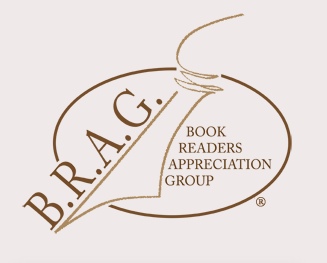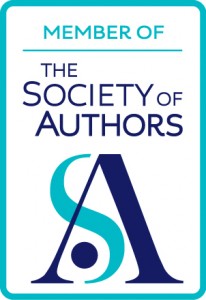 JJ Marsh grew up in Wales, Africa and the Middle East, where her curiosity for culture took root and triggered an urge to write. After graduating in English Literature and Theatre Studies, she worked as an actor, teacher, writer, director, editor, journalist and cultural trainer all over Europe. JJ Marsh grew up in Wales, Africa and the Middle East, where her curiosity for culture took root and triggered an urge to write. After graduating in English Literature and Theatre Studies, she worked as an actor, teacher, writer, director, editor, journalist and cultural trainer all over Europe.
Now based in Switzerland, Jill is a founder member of Triskele Books, forms half of The Woolf Quarterly and is a regular columnist for Words with JAM and Displaced Nation. She lives with her husband and three dogs, and in an attic overlooking a cemetery, she writes.
JJ and I met in a distanced way on Facebook – we both belong to the Alliance of Independent Authors – but when she and I were both selected as indie Editor’s Choices in prestigious UK publishing trade magazine ‘The Bookseller’, I decided I needed to investigate further…
Welcome, JJ!
Now, I read Cold Pressed, your most recent crime mystery, and enjoyed it very much. Beatrice Stubbs, your heroine… (Or do you prefer “female protagonist”?) Where does she come from? Is she entirely imaginary?
I really had to think about that one. She’s been with me so long, and most definitely a heroine. I’ve always been drawn to writing characters older and wiser than myself. The spark of an independent woman, battling all the pressures that come with age and experience, struck me in the late 90s. I met a woman who personified the unconventional. As I do with every intriguing character, I put her in my notebook.
I just had to find the right vehicle for her. When I decided to tackle the credit crunch and the morality (or lack of) in contemporary capitalism, she became the essence of Beatrice Stubbs. Wholly unrecognisable from the original, but there is a disguised thank-you in every book.
How do you research the procedural background?
By hassling the experts. In Switzerland, I happened to meet a special police officer at a social event. He’s regretted it ever since. Wine vendors, social services, cruise workers, security officers and locals have all added an incredibly generous amount of authenticity to my work.
 Zurich at night (Photo courtesy of Libby O) The Internet is handy, but if you connect with an individual who’s excited about the idea? Put it this way – I’m still corresponding with a butcher and a maker of model cars, despite neither element making it into the book.
The area in which I am most scrupulous is the procedures surrounding mental health. Beatrice’s battles with her bipolar condition and conversations with her therapist are carefully researched and checked with two clinical psychologist friends.
Zurich, Spain, the Greek Islands – Beatrice gets around. Why do you set her stories outside the UK?
Locations inspire atmosphere. I’m a massive Europhile and for me, places trigger stories.
 San Sebastian harbour (Photo courtesy of JD Lewis) Corporate crime and punishment seemed perfect for Zürich. Rioja and revenge – where else but Spain? My homage to the Golden Age had to be on a train or a cruise, so Greece it was. Not all my Beatrice books are set outside the UK – Raw Material is set in Finsbury Park and Pembrokeshire.
My definition of literary genius is writing about places you want to visit. We’re off to a wild island between Denmark and Germany next.
What is the single most important way to establish your characters in the reader’s mind?
I have to take readers inside my character’s head. None of this looking-in-the-mirror-and-describing-themselves nonsense. Who really does that? The only thing I ever say aloud while looking in the mirror is ‘Oh God, what a mess’.
 Athens at night I deliberately held back physical details of Beatrice’s appearance, so the reader must gain a picture from what other characters say about her.
But you know what she’s thinking. You are in her point of view even when observing from the outside (I write in the third person) and most importantly, you are on her side. It gets really interesting when you are on the sides of opposing characters and you want both, impossibly, to win.
I’d add that over four books (book five in progress) about the same character, she has to develop and be consistent. And most importantly, misbehave.
(Ha! Misbehave? Yes, all heroines should do that at least part of the time.)
Find out more about Beatrice http://www.beatrice-stubbs.com
So what’s Cold Pressed about?
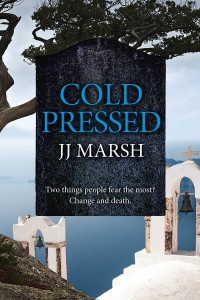 Santorini. Turquoise seas, ancient ruins and beautiful sunsets. Santorini. Turquoise seas, ancient ruins and beautiful sunsets.
And a woman thrown from a cliff.
The violent death shocks fellow passengers of the Empress Louise, a grand cruise liner packed with British tourists.
For newly promoted Inspector Nikos Stephanakis, the case poses linguistic and cultural problems. His request for assistance yields unexpected results.
DI Beatrice Stubbs, called in as support, flies to Greece. What with tension at home, the timing couldn’t be better. She anticipates a few days in the sun and a swift resolution.
But when an earlier death at sea proves suspicious and an elderly lady is killed in her cabin, terror spreads like contagion. Murder is aboard.
And someone has Beatrice in his sights.
From the Cyclades to the Dodecanese, Nikos and Beatrice pursue the killer and unearth a secret.
Revenge is a dish best served cold.
“This is J J Marsh’s fourth, snappily written crime mystery featuring the feisty but vulnerable Stubbs, a most appealing character. It’s all highly diverting, and an ideal read for those who like their crime with a lighter, less gruesome touch.” – Caroline Sanderson, The Bookseller
Fascinated? Buy on Amazon
Thank you, JJ Marsh for joining me on the blog today. Lovely to celebrate success with you!
If you enjoyed this post, do share it with your friends!Like this:Like Loading...
 My writing desk at Lumb Bank When I started my first novel, INCEPTIO, I had no idea what I was doing. Writing was an impulse, a reaction to a dire film and thinking I could produce something better. But not even halfway through the first draft, I realised I had a far bigger story than I’d anticipated. So I did the classic thing – I was going to make a trilogy.
While I was scribbling book 1, my focus shifted to planning book 2, which was going to be the pivot for books 1 and 3. Some trilogies develop from book 1 and the original story can widen out into an impossible sprawl in order to make each book more exciting than the previous one. Not for me!
Although I saw it differently at the time, the eighteen months of submitting my work to agents and publishers of book 1 gave me an invaluable period in which to plan, draft and hone the whole trilogy. I blush at what INCEPTIO would have been like without that maturation.
So what did I learn and what are my tips to pass on to other writers?
1. Work out the entire plot in advance
All three of my books are set in an imaginary country, Roma Nova, and follow the adventures of the same heroine, from when she (and the reader!) discovers Roma Nova to sixteen years later. And, of course, she will save the world and hopefully herself. But that’s too vague. Each book needs its own story, but one which contributes to the plot arc of the trilogy.
Crudely speaking, apart from the individual thriller story, book 1 sets the scene, introduces the world, the ‘rules’ of that world and the main characters. Book 2 consolidates, widens and sets the ground for the final reckoning in book 3. However, each book must stand on its own as a complete story. A reader may pick up book 2 first and while they may be eager to find out what went before and what happened afterwards, they must have a satisfying read from the book they bought. Writers need to drip in enough backstory to bring the new reader up to speed without boring the established fan.
2. Know your characters in advance
 Adding a raft of new characters in each book is tempting. I confess to a fair number of characters, but Roma Nova operates on collectivities like families, military, even criminal organisations. Adding a raft of new characters in each book is tempting. I confess to a fair number of characters, but Roma Nova operates on collectivities like families, military, even criminal organisations.
Recycling characters in each book not only helps eliminate ‘character creep’, but is a pleasure for both writer and reader as we see each individual develop his or her own story. However, you do need new people now and again and however reluctantly, you should kill off one or two or you risk making your world too much like Shangri-La or Pleasantville.
3. Work out big secrets in advance and scatter little ones throughout all the books
As a reader, I like a good, heavy surprise at the end of books, or at least a ‘twist in the tale’ and hints about this should pop up throughout the book. As a writer, I love laying ‘Easter eggs’ in one book that hatch in another. I was lucky that I was able to do this with INCEPTIO, PERFIDITAS and SUCCESSIO as I had all first drafts written before INCEPTIO finally went to print.
4. Intrigue by revelation over a longer stretch
With a trilogy, you have the advantage of being able to reveal backstory and other facets of your characters over a longer span. This needs to be done carefully and not be an excuse for padding. In an epic, saga or high concept story, we all love ‘deep lore from the past’, hidden family secrets or a forbidden passion. Timely revelations also strengthen the bonds between the books.
5. Practicalities
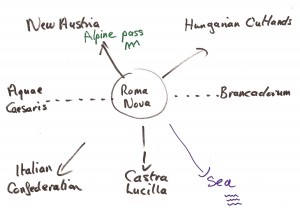 Your head may be stuffed with information about your setting, you may have notebooks or files full of research or you may just live in your books’ world. But you need to have consistent information to hand on the internal values and culture, governmental, societal and economic structures, geography, history, sources of income, education, food, religion and, of course language. Your head may be stuffed with information about your setting, you may have notebooks or files full of research or you may just live in your books’ world. But you need to have consistent information to hand on the internal values and culture, governmental, societal and economic structures, geography, history, sources of income, education, food, religion and, of course language.
I don’t have a map, but I do know where Roma Nova is and that Castra Lucilla in to the south of the city and Aquae Caesaris and Brancadorum are to the west and east respectively.
I maintain a list of characters for each book, remembering to update it in the next as characters change job, get promoted, married, or move on. Something I’ve found indispensable is a spreadsheet of ages, tracking who is what age when something happens and preventing character X being older that his mother.
The very worst thing? I’m speaking as a reader here. When something or somebody pops up like a deus ex machina in a sequel or directly contradicts something in a previous book and there has not been the least hint about it. Even if you as a writer think up the cleverest idea in the world, don’t do it! Star Trek fans will cringe at the memory of the controversy over the changed Klingon physical appearance. One character told the humans not to ask – it was a Klingon-only secret – and another said it was due to a terrible disease in the past. Hm.
The trilogy in evolution?
Well, SUCCESSIO, the third Roma Nova thriller, set off into the world last June. But the books don’t end there – readers clamoured for further Roma Nova stories and I have plenty more in my story box. So I turned the ‘trilogy’ into the start of a series. I have at least three more planned around a significant secondary character and then, who knows?
Updated: Alison Morton is the author of Roma Nova thrillers INCEPTIO, PERFIDITAS, SUCCESSIO, AURELIA and INSURRECTIO. The sixth, RETALIO, will be published in Spring 2017. Audiobooks now available for the first four of the series
Find out more about Roma Nova, its origins, stories and heroines… Get INCEPTIO, the series starter, for FREE when you sign up to Alison’s free monthly email newsletter
If you enjoyed this post, do share it with your friends!Like this:Like Loading...
 A Birmingham author and member of the Historical Novel Society, Elaine grew up in an Anglo-Italian family. She attributes her lifelong interest in story-telling to the roguish tales her grandfather told of his Italian childhood, and family holidays visiting ancient burial sites and stone circles. She loves languages, history and travel and lives with her family and their chocolate labrador. A Birmingham author and member of the Historical Novel Society, Elaine grew up in an Anglo-Italian family. She attributes her lifelong interest in story-telling to the roguish tales her grandfather told of his Italian childhood, and family holidays visiting ancient burial sites and stone circles. She loves languages, history and travel and lives with her family and their chocolate labrador.
Congratulations on the release of your first title Wulfsuna, set in AD 433. Now, as a ‘Roman’, I’d like to know how much connection, or not, you felt to the shadow of the Roman presence in Britain as you described the Wolf Sons’ adventure?
First of all, thank you very much Alison for inviting me to be a guest on your blog. Wulfsuna seems to have had a good start in life and I’m so happy to be sharing it with everyone.
 From the first moments of writing Wulfsuna I was conscious of what presence may, or may not, remain of the Roman Empire’s influence in mid-5th century Britain. The first prose I wrote was for my heroine, a young Romano-British resident of a wealthy, wool-trading settlement. Her story relied heavily on how much (or how little) others in her community had held onto, or released the ideals of Roman life. Unable to obtain much written evidence and with varying professional opinions that were no more than assumptions, I chose to use this to my advantage. From the first moments of writing Wulfsuna I was conscious of what presence may, or may not, remain of the Roman Empire’s influence in mid-5th century Britain. The first prose I wrote was for my heroine, a young Romano-British resident of a wealthy, wool-trading settlement. Her story relied heavily on how much (or how little) others in her community had held onto, or released the ideals of Roman life. Unable to obtain much written evidence and with varying professional opinions that were no more than assumptions, I chose to use this to my advantage.
In such an unstable economic climate, even a 5th century one, I imagined there would be divided opinion: those who wanted to retain their Roman way of life and feasibly others who yearned to rediscover their Brytonic roots. For instance, under the Empire the carrying of weapons had been forbidden. With an increasing threat from several Germanic tribes in the east, freedom to carry arms would have been enticing to many wealthy landowners. Likewise, the subservience of women, as was the case in Roman culture, could have been something female Romano-Brytons craved. A return to the liberating ‘woman of the house’ ideal of their maternal ancestors must also have been a lure. Finally, setting my novel twenty years or so after Rome’s departure meant a generation had passed and along with it, as nowadays, their elders’ views and ideals. The youth of the time would be looking to forge futures of their own, in a world independent of Rome and under threat from foreign attack.
What has been the most surprising thing – good or bad – on your journey to publication? And during your research?
Believe it or not, I hated the idea of Twitter and yawned derisively at yet another social media platform. My husband encouraged me to join and I soon discovered it to be a great place to meet other writers, either starting out as I was, or published authors; that all of these word-lovers conversed as equals was a revelation to me. Access to professional authors and their wealth of experience has aided me greatly in my journey to publication. Writing is no longer a lonely profession!
 Another stand-out moment for me was sending Wulfsuna off for a professional edit, advised by one of the authors I had met online. I bit the bullet and paid the fee. When I received the 6-page report I cried and hid the paperwork away for a week. Eventually I forced myself to read it thoroughly and made notes. The result meant a huge rewrite and the addition of several chapters, but I am extremely happy I followed it through. (Ha! Some encouragement here on using reader reports) Another stand-out moment for me was sending Wulfsuna off for a professional edit, advised by one of the authors I had met online. I bit the bullet and paid the fee. When I received the 6-page report I cried and hid the paperwork away for a week. Eventually I forced myself to read it thoroughly and made notes. The result meant a huge rewrite and the addition of several chapters, but I am extremely happy I followed it through. (Ha! Some encouragement here on using reader reports)
As for surprises in research, I asked a re-enactment friend to take me through some Saxon combat moves to assist me in adding some realism to battle scenes. I never realised the equipment weighed so much! Struggling beneath a helmet that felt as though it was going to snap my neck and taken off-balance by a 3-foot shield, it took all my strength to stand, let alone fight. However, these sensations and the smell and feel of all the equipment gave me a peek into the world of the Saxon warrior, which I would not have obtained simply reading about it.
I would never had believed you were a reluctant Tweeter, Elaine!
So what’s Wulfsuna about?
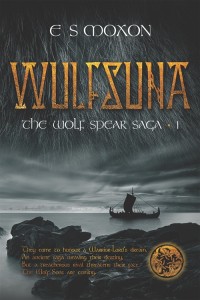 AD433. Torn apart when Rome abandoned Bryton, the Wulfsuna are a disparate tribe. AD433. Torn apart when Rome abandoned Bryton, the Wulfsuna are a disparate tribe.
Twenty years on, two long ships sail for the east fens to honour their Warrior-Lord’s dream and reunite with lost kin. Soon after landing however, a murderous betrayal divides loyalties, some craving revenge and others indignant on pursuing their Lord’s dream. Blood and brotherhood are tested to their deadly limits.
The discovery of a young Seer adds to the turmoil. Expelled from her village after foretelling of an attack by blue painted savages, the Wulfsuna are equally wary of one they call ‘Nix’. None fear her more than Lord Wulfgar, who refuses to believe an ancient saga bearing his name, is weaving the Seer’s destiny into his own. But a treacherous rival threatens their fate and Wulfgar must accept the Seer’s magic may be all that can save them.
Wulfsuna is available now from Amazon UK, Amazon US, Kobo, and the paperback direct from SilverWood Books or via any bookshop. Watch the book trailer.
Find out more about Elaine, Wulfsuna and post-Roman Britain on her blog. Connect with her on Facebook, Twitter and Goodreads.
Thank you, Elaine. I’m reading Wulfsuna at the moment – looking good!
Alison Morton writes the Roma Nova thrillers, INCEPTIO, and PERFIDITAS. Third in series, SUCCESSIO, is now out.
Find out more about Roma Nova, its origins, stories and heroines…
If you enjoyed this post, do share it with your friends!Like this:Like Loading...
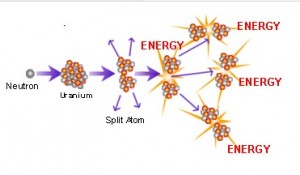 So, split the atom time. Well, as I’ve created two blogs out of one, it’s more a case of splitting the byte. So, split the atom time. Well, as I’ve created two blogs out of one, it’s more a case of splitting the byte.
Being an author today means developing entrepreneurial skills, especially marketing ones. I’m not talking about selling – although that’s ultra important – but about making people aware of your book’s, or books’, existence. It’s a slippery concept, marketing, but for me it means setting out your wares, and creating an environment that supports that.
But bewilderment grows if you try to include everything in one wrapper (or blog). Think of your weekly grocery shopping expedition at the supermarket; milk, eggs, bread, veg, fruit, meat/fish, juice, yoghurt, cereal, tea, coffee, etc. Basically food, with a bottle of shampoo and some multiple purpose cleaning product thrown in. But wait, you can also buy clothes, petrol, books, cameras, TV, tyres, banking services, insurance, a holiday.
Confused?
Well, I am. If I want a bank, I go to an, er, bank. For my insurance, I go to an insurer or broker, tyres come from a garage, a holiday from an online specialist or a travel agent – all dedicated to that sector and usually giving you a wide choice and good advice. I know where I am with a specialist.
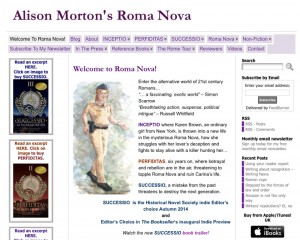 My website, originally Write A Novel? I Must Be Mad! had one main theme – a newbie’s adventures in writing-and-publishing-land, peppered with the odd post about Rome and alternative history. When my first book, INCEPTIO, came out, I changed it to Alison Morton’s Roma Nova and added in stuff about my books. My website, originally Write A Novel? I Must Be Mad! had one main theme – a newbie’s adventures in writing-and-publishing-land, peppered with the odd post about Rome and alternative history. When my first book, INCEPTIO, came out, I changed it to Alison Morton’s Roma Nova and added in stuff about my books.
Now with the fourth book, AURELIA, on the way, it’s time for another change. I asked for specialist advice. Reading the report (with a slightly sinking heart), I had to agree with it and acknowledge that Alison Morton’s Roma Nova was too fuzzy and cluttered. People looking for my books also got a raft of writing topics; others looking for writing and publishing kept getting all this Roman and Roma Nova stuff.
But I didn’t want to abandon any group of readers, so I put my site-splitting gloves on and decided to develop in both directions. In the past six years, I’ve accumulated knowledge and experience on writing and publishing topics and techniques and, while in no way setting myself up as a guru, would like to pass them on. Whether you want to read them is up to you. 😉
On Alison Morton’s Writing Blog (here!) you’ll be able to find my posts about writing, independent publishing, marketing, fabulous guests, research, author-entrepreneur skills, writing life and what I’ve been up to!
The darker Alison Morton, Author of the Roma Nova Thrillers features my books, plus this is where I’ll concentrate my photos and posts about Rome, alternative history and background about Roma Nova. And I have a very serious photo and tough new bio there…
Alison Morton is the author of Roma Nova thrillers, INCEPTIO, and PERFIDITAS. Third in series, SUCCESSIO, is now out.
Find out more about Roma Nova, its origins, stories and heroines…
If you enjoyed this post, do share it with your friends!Like this:Like Loading...
 This is one for the writers, but readers might be interested in a vital part of the process that goes to producing a story. I say producing, because like a piece of pottery, a story starts as a heap of dull, wet mud. Writing the first draft is like throwing that heap on to the wheel and teasing out a not-too-bad shape. After several tries, and a lot of concentration, hard work an a dollop of inspiration, you eventually have a well-shaped story which holds together, with no holes and no obvious imperfections. Now it has to be finished, decorated and glazed before firing in the publishing process. (Or do I mean kiln?) This is one for the writers, but readers might be interested in a vital part of the process that goes to producing a story. I say producing, because like a piece of pottery, a story starts as a heap of dull, wet mud. Writing the first draft is like throwing that heap on to the wheel and teasing out a not-too-bad shape. After several tries, and a lot of concentration, hard work an a dollop of inspiration, you eventually have a well-shaped story which holds together, with no holes and no obvious imperfections. Now it has to be finished, decorated and glazed before firing in the publishing process. (Or do I mean kiln?)
Writers use different finishing routes; mine always includes a professional (yes, parting with money!) report. If you are lucky enough to be a member of the Romantic Novelist’ Association’s New Writers Scheme, you will receive a massively subsidised report as part of your membership.
Professional readers can be multi-published authors, editors, creative writing tutors or literary consultants. Obviously, you will have checked out their qualifications and track record. Personal recommendation and references are vital; you are handing over your hours of hard graft, inspiration and possibly a part of your soul.
After a few weeks, the report drops into your inbox. Whether it’s the first time or the fourth time (as it is for me), the feelings of excitement and dread intermingle; did the reader ‘get’ your story? Is it a potential bestseller or a heap of crap? Are they going to suggest you take up accountancy instead?
 Make a cup of tea/coffee and open the damned thing; it’s done. This may sound hard, but nothing you feel now is going to change the report. You’ll be better off using that nervous energy in working on the revisions which result from it. But I’m getting ahead of myself – something I am told I do when I read my report. 😉 Make a cup of tea/coffee and open the damned thing; it’s done. This may sound hard, but nothing you feel now is going to change the report. You’ll be better off using that nervous energy in working on the revisions which result from it. But I’m getting ahead of myself – something I am told I do when I read my report. 😉
Let’s get practical
1. Sit quietly and read through it fairly quickly. That gets rid of anticipation and you can then read the content properly and with your writing brain rather than your emotions.
2. Then look at the structure of the report. Usually, there’s a general/introductory section at the beginning (usually with some nice words!), followed by headed sections about the chief concerns, for example, start of the story, each major character, minor characters, setting/world building, plot, then options and ways forward.
3. Reports will normally pinpoint only the weaker areas. If something isn’t mentioned or is only included in the introductory section with praise, then you’ve cracked those areas and don’t need to worry.
4. Print the report out in 1.5 spacing, or double, if you prefer. (I use up my old business letterhead for this internal stuff, so ignore the logo in the image.) Next mark up the report. You can’t use it effectively until you’ve analysed it. I underline the key words/phrases, e.g. “One of your strengths is writing action scenes.” I don’t need to underline “They are all terrific, immediate, visceral” which develops that comment, although I do go back and read it when I have an attack of self-doubt!
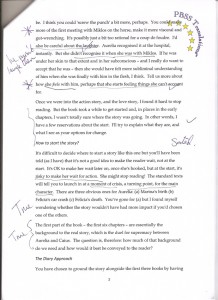 Moving on… “You have a lovely turn of phrase” I just tick that – job done. Then you read ”But I’d be careful about…” For me that’s a massive asterisk in the margin – an action point that must be addressed. I mark up things where I see the reader is right with ’True’. This alerts me to revisit that section of my manuscript. And importantly, any factual queries, I mark with ‘Check’. Doing this analysis methodically takes the sting out of any negatives identified. You are a in worker mode rather than reactor mode. Moving on… “You have a lovely turn of phrase” I just tick that – job done. Then you read ”But I’d be careful about…” For me that’s a massive asterisk in the margin – an action point that must be addressed. I mark up things where I see the reader is right with ’True’. This alerts me to revisit that section of my manuscript. And importantly, any factual queries, I mark with ‘Check’. Doing this analysis methodically takes the sting out of any negatives identified. You are a in worker mode rather than reactor mode.
5. If the reader has also annotated the text, work through those comments first, bearing in mind the overall points made in the report. A warning – you will find other things the reader hasn’t mentioned but which scream out at you now your senses are alerted. This is a great opportunity to tighten up other parts of the text and snip bits out of scenes that you now see are superfluous. And to develop scanty scenes which could contribute much more.
6.When you’ve finished that run through, have a glass of wine to celebrate. (Juice/tea/coffee as you prefer, but I need wine at this stage.)
7. Next day, sit at your keyboard and work through the general points underlined in the report. If it’s a major restructure, print out the sections/chapters concerned and work on them with a pen. You will be able to scribble, circle and arrow them much more easily than on the screen. You may even find a pair of scissors and a stapler/gluestick handy…
You may feel you’re starting all over again, but altering the detailed comments in the days before will have slotted you back into the story after a break of several weeks. I’ll ‘fess up – I had dithered around at the start of my latest manuscript, AURELIA, and had several interesting but redundant chapters at the beginning. Following the advice in my report, I consigned six chapters to the pyre, but two tighter chapters, full of tension, emotion and action, emerged from the flames.
8. No, you haven’t finished! Send the revised manuscript to your Kindle/print it out in single spacing and read it through as if it were a ‘real book’. Make notes, but don’t stop to change anything or you’ll lose the flow.
9. Incorporate changes you have spotted on your read through.
10. Send the manuscript to a trusted friend/critique partner/beta reader asking them to comment on the reader experience. They shouldn’t spot spelling, bad grammar and typos; you will have sorted out those glitches by now.
11. Final check and then send the manuscript off to the next stage, be it agent, publisher, or as I do to my copy editor before it I publish it under my Pulcheria Press imprint.
 Now is definitely time to celebrate – you’ve achieved a huge step in your book’s existence. Now is definitely time to celebrate – you’ve achieved a huge step in your book’s existence.
Sometimes, a reader report is a genuine dud, but not often. In that case, go back to the reader/organisation and set out your points logically why it didn’t meet your expectations; keep the emotion out. Out of six reports from various sources, I’ve only had one poorly produced one and even the scheme organiser thought it wasn’t very good and offered me a second one free!
A reader’s job is not to slate, target or destroy your work and your confidence, but to show you weaknesses, and offer you ways to remedy them. They are industry professionals who want good books for the public. However emotionally you feel about it at first, do the hard work on it and it will not only make the current story better but also help you develop as a writer.
Any other tips?
Updated November 2021: Alison Morton is the author of Roma Nova thrillers – INCEPTIO, CARINA (novella), PERFIDITAS, SUCCESSIO, AURELIA, NEXUS (novella), INSURRECTIO and RETALIO, and ROMA NOVA EXTRA, a collection of short stories. Audiobooks are available for four of the series.Double Identity, a contemporary conspiracy, starts a new series of thrillers. Double Pursuit, the sequel, is now out!
Find out more about Roma Nova, its origins, stories and heroines and taste world the latest contemporary thriller Double Identity… Download ‘Welcome to Alison Morton’s Thriller Worlds’, a FREE eBook, as a thank you gift when you sign up to Alison’s monthly email newsletter. You’ll also be among the first to know about news and book progress before everybody else, and take part in giveaways.
If you enjoyed this post, do share it with your friends!Like this:Like Loading...
|
Subscribe to Blog via Email
Join 50 other subscribers.
Categories
Archive
|
 JJ Marsh grew up in Wales, Africa and the Middle East, where her curiosity for culture took root and triggered an urge to write. After graduating in English Literature and Theatre Studies, she worked as an actor, teacher, writer, director, editor, journalist and cultural trainer all over Europe.
JJ Marsh grew up in Wales, Africa and the Middle East, where her curiosity for culture took root and triggered an urge to write. After graduating in English Literature and Theatre Studies, she worked as an actor, teacher, writer, director, editor, journalist and cultural trainer all over Europe. Santorini. Turquoise seas, ancient ruins and beautiful sunsets.
Santorini. Turquoise seas, ancient ruins and beautiful sunsets.

















